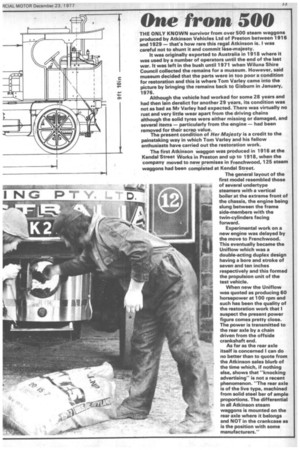One from 500
Page 35

If you've noticed an error in this article please click here to report it so we can fix it.
THE ONLY KNOWN survivor from over 500 steam waggons produced by Atkinson Vehicles Ltd of Preston between 1916 and 1929 — that's how rare this regal Atkinson is. I was careful not to shunt it and commit lese-majesty.
It was originally exported to Australia in 1918 where it was used by a number of operators until the end of the last war. It was left in the bush until 1971 when Wiluna Shire Council collected the remains for a museum. However, said museum decided that the parts were in too poor a condition for restoration and this is where Tom Varley came into the picture by bringing the remains back to Gisburn in January, 1976.
Although the vehicle had worked for some 28 years and had then lain derelict for another 29 years, its condition was not as bad as Mr Varley had expected. There was virtually no rust and very little wear apart from the driving chains although the solid tyres were either missing or damaged, and several items — particularly from the engine — had been removed for their scrap value.
The present condition of Her Majesty is a credit to the painstaking way in which Tom Varley and his fellow enthusiasts have carried out the restoration work.
The first Atkinson waggon was produced in 1916 at the Kendal Street Works in Preston and up to 1918, when the company moved to new premises in Frenchwood, 125 steam waggons had been completed at Kendal Street.
The general layout of the first model resembled those of several undertype steamers with a vertical boiler at the extreme front of the chassis, the engine being slung between the frame side-members with the twin-cylinders facing forward.
Experimental work on a new engine was delayed by the move to Frenchwood. This eventually became the Unif low which was a double-acting duplex design having a bore and stroke of seven and ten inches respectively and this formed the propulsion unit of the test vehicle.
When new the Unitlow was quoted as producing 60 horsepower at 100 rpm and such has been the quality of the restoration work that I suspect the present power figure comes pretty close. The power is transmitted to the rear axle by a chain driven from the offside crankshaft end.
As far as the rear axle itself is concerned I can do no better than to quote from the Atkinson sales blurb of the time which, if nothing else, shows that "knocking advertising" is not a recent phenomenon. "The rear axle is of the live type, machined from solid steel bar of ample proportions. The differential in all Atkinson steam waggons is mounted on the rear axle where it belongs and NOT in the crankcase as is the position with some manufacturers."




































































